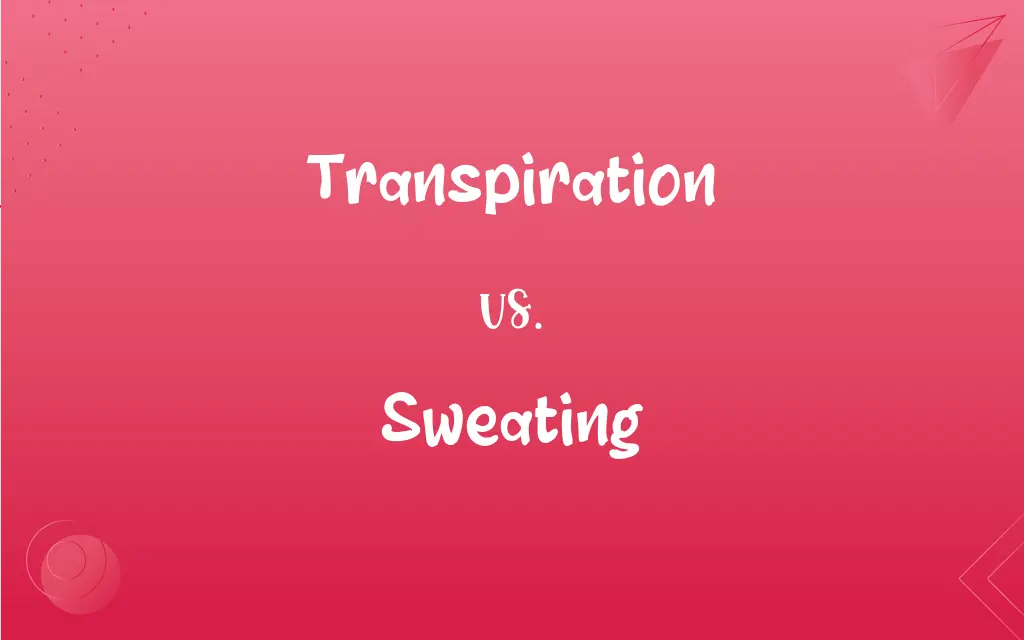Transpiration vs. Sweating: What's the Difference?
Edited by Aimie Carlson || By Janet White || Updated on December 20, 2023
Transpiration is the process of water movement through plants and its evaporation from aerial parts, while sweating is the secretion of fluids by sweat glands in animals and humans.

Key Differences
Transpiration occurs in plants, involving the evaporation of water from plant leaves. Sweating, on the other hand, is a process in animals and humans, where sweat glands release moisture to cool the body.
Transpiration helps in water and nutrient movement in plants and temperature regulation. Sweating primarily aids in thermoregulation and the excretion of salts in animals and humans.
Transpiration takes place mainly through the stomata on plant leaves. Sweating occurs through specialized sweat glands located in the skin of animals and humans.
The liquid in transpiration is almost entirely water. Sweat contains water along with salts and other organic compounds.
Transpiration is not directly visible, but its effects can be seen in the plant’s health and growth. Sweating is visibly noticeable as moisture on the skin.
ADVERTISEMENT
Comparison Chart
Biological Process
Evaporation of water from plants
Secretion of fluid by sweat glands in animals/humans
Main Purpose
Water and nutrient transport, cooling
Body temperature regulation, excretion
Occurrence Location
Stomata on leaves
Sweat glands in skin
Composition of Fluid
Mostly water
Water, salts, organic compounds
Visibility
Indirectly observed through plant health
Directly visible on skin
ADVERTISEMENT
Transpiration and Sweating Definitions
Transpiration
A part of the water cycle involving plants.
Transpiration helps maintain the ecosystem’s water balance.
Sweating
To excrete perspiration through the pores.
He was sweating after the long run.
Transpiration
The release of water vapor from plant leaves.
Transpiration in plants increases on hot days.
Sweating
The secretion of fluids by the body's sweat glands.
Sweating is more common during physical exercise.
Transpiration
Movement of water through a plant to the atmosphere.
Transpiration is vital for a plant’s nutrient uptake.
Sweating
A process of cooling the body.
Sweating helps regulate body temperature in hot weather.
Transpiration
Evaporation of water from plant surfaces.
Scientists measure transpiration to understand plant health.
Sweating
To release moisture on the skin’s surface.
She started sweating during the intense workout.
Transpiration
The process where plants lose water to the air.
Gardeners must consider transpiration when watering plants.
Sweating
The excretion of salts and fluids from the skin.
Sweating can lead to dehydration if not replenished.
Transpiration
The act or process of transpiring, especially through the stomata of plant tissue or the pores of the skin.
Sweating
To excrete perspiration through the pores in the skin; perspire.
Transpiration
(botany) The loss of water by evaporation in terrestrial plants, especially through the stomata; accompanied by a corresponding uptake from the roots.
Sweating
To exude in droplets, as moisture from certain cheeses or sap from a tree.
FAQs
Does transpiration occur at night?
It's reduced at night, as stomata often close in the dark.
Can sweating occur all over the body?
Yes, especially where there are more sweat glands.
How does transpiration benefit plants?
It aids in nutrient transport and temperature regulation.
Is transpiration visible?
Not directly, but its effects on plant health are observable.
Can you sweat without exertion?
Yes, due to heat, emotions, or certain health conditions.
Does transpiration use up a lot of water?
Yes, a large portion of absorbed water is lost via transpiration.
Are transpiration and evaporation the same?
No, transpiration is specific to water movement through plants.
Is it possible to sweat too much?
Yes, excessive sweating can occur in certain conditions.
What triggers sweating in humans?
Heat, exercise, stress, or medical conditions can trigger sweating.
What factors affect transpiration rates in plants?
Temperature, humidity, wind, and light intensity.
What is excessive sweating called?
Hyperhidrosis is the medical term for excessive sweating.
What role does transpiration play in the water cycle?
It's a key component, returning water vapor to the atmosphere.
Are there diseases related to sweating?
Yes, like hyperhidrosis or anhidrosis (lack of sweating).
Do all plants transpire?
Most plants do, but rates vary among species.
Does transpiration differ in aquatic plants?
Yes, it's generally less as they have abundant water access.
Is sweating solely for cooling?
Mainly, but it also helps excrete waste products.
Can dehydration affect sweating?
Yes, dehydration can reduce the ability to sweat effectively.
Can sweat be odorless?
Yes, sweat itself is generally odorless; odor comes from bacteria.
Does sweating detoxify the body?
It helps eliminate some toxins, but the liver and kidneys do most detoxification.
Can transpiration be controlled in plants?
To some extent, through environmental conditions like humidity.
About Author
Written by
Janet WhiteJanet White has been an esteemed writer and blogger for Difference Wiki. Holding a Master's degree in Science and Medical Journalism from the prestigious Boston University, she has consistently demonstrated her expertise and passion for her field. When she's not immersed in her work, Janet relishes her time exercising, delving into a good book, and cherishing moments with friends and family.
Edited by
Aimie CarlsonAimie Carlson, holding a master's degree in English literature, is a fervent English language enthusiast. She lends her writing talents to Difference Wiki, a prominent website that specializes in comparisons, offering readers insightful analyses that both captivate and inform.







































































